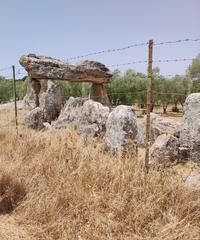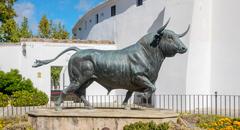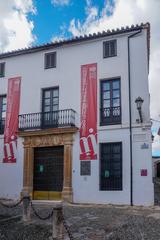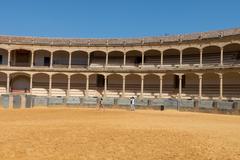Ermita de San Miguel, Ronda, Spain: Visiting Hours, Tickets, and Historical Site Guide
Date: 03/07/2025
Introduction
Set amid the dramatic valleys and rolling hills of Ronda, Andalusia, the Ermita de San Miguel is a tranquil hermitage steeped in centuries of history. Revered as a spiritual retreat and a symbol of Ronda’s layered past, this hermitage connects visitors to the city’s Christian, Islamic, and Jewish heritage. Whether you are a history enthusiast, cultural traveler, or someone seeking solace and stunning views, this comprehensive guide will help you plan a fulfilling visit to one of Ronda’s most meaningful yet understated monuments (Evendo, Plusesmas, Slow Ronda).
Historical Origins and Cultural Significance
Layers of Sacredness
The site of the Ermita de San Miguel embodies Ronda’s complex spiritual evolution. Archaeological and documentary evidence suggests its use for religious purposes dates back to the Visigothic or Mozarabic periods, possibly as part of a network of cave sanctuaries. During the Islamic era, the area formed part of Ronda’s Arrabal Bajo, a multi-faith suburb that included a mosque and synagogue (Plusesmas, Andalucía Rústica, Inside Malaga). After the Christian Reconquista in 1485, the mosque was replaced by the present-day hermitage, and the synagogue was converted into a chapel.
Christian Devotion and Community Life
After its dedication to Saint Michael the Archangel—a figure symbolizing protection and guidance—the hermitage became an important focal point for Christian worship, especially among the local tanning industry’s workers and their families. The plaza outside hosted lively community celebrations such as the “Toros de Fuego” in honor of San Miguel (Ronda.ws), underscoring the hermitage’s role in both spiritual and communal life.
Syncretism and Transformation
The hermitage’s existence on a site previously home to mosques and synagogues demonstrates the region’s religious syncretism. This blending is visible in the area’s architectural and cultural traditions, as well as in local festivals that continue to celebrate Saint Michael’s feast day with processions and gatherings (Iglesias Locales, Inside Malaga).
Architecture and Setting
Traditional Andalusian Design
The Ermita de San Miguel exemplifies classic Andalusian rural religious architecture: whitewashed walls, a terracotta-tiled roof, and a small bell gable. Its simple interior—accented by rustic doors, stone floors, and minimal ornamentation—reflects its origins as an ascetic retreat and a place for quiet reflection (Evendo).
Artistic Features
Inside, you’ll find religious murals and sculptures from various periods, providing insight into Ronda’s devotional practices and artistic heritage (Iglesias Locales). The hermitage’s integration with the rocky hillside echoes ancient cave sanctuaries common in the region (Plusesmas).
Integration with the Landscape
Strategically situated on the city’s edge, the hermitage offers panoramic views of the surrounding valleys, making it both a spiritual haven and an excellent photographic spot. Approaching the site involves scenic walks through wildflowers and native vegetation (Evendo).
Visiting Information
Location
Located in Ronda’s San Francisco neighborhood near the city’s ancient gates, the hermitage is easily included in walking tours of the old town. It sits close to major attractions such as the Almocábar Gate, the Iglesia del Espíritu Santo, and the Arab Baths (Slow Ronda).
Getting There
- By Foot: The hermitage is a 15–30 minute walk from Ronda’s old town center.
- By Car: Limited parking is available in the San Francisco area. Most visitors park at the edge of the historic center and walk.
- By Public Transport: The Ronda train and bus stations are within a kilometer of the old town (The Viva La Vita).
Visiting Hours
- Standard Hours: Open to visitors during daylight hours, typically from 9:00 AM to 6:00 PM.
- Special Events: Hours may extend during festivals, especially the feast of San Miguel in late September.
- Note: The hermitage may only open for services or by arrangement outside of festival times. Check with the Ronda Tourist Information Office for current details.
Tickets and Entry
- Admission: Free of charge; donations are welcome to support preservation.
- Guided Tours: Available as part of broader Ronda walking or historical tours, especially during local festivals (Slow Ronda).
Accessibility
- Terrain: Access involves cobbled streets and some inclines, typical of Ronda’s historic core.
- Mobility: The site is not fully wheelchair accessible; those with mobility concerns should plan accordingly or contact the tourist office for advice.
- Facilities: No restrooms or shaded seating on-site; these are available in the city center.
Photography and Etiquette
- Photography: Allowed outside; be discreet and respectful inside, especially during services.
- Dress Code: Modest clothing is appreciated; cover shoulders and knees, especially during religious events.
Enhancing Your Visit
Best Time to Visit
- Season: Spring (March–May) and autumn (September–November) offer mild weather and fewer crowds (Voyage Tips).
- Festivals: Visit during the San Miguel festival in late September for vibrant processions and local cultural immersion.
What to Bring
- Comfortable footwear (cobbled streets)
- Sun protection and water (especially in summer)
- Cash for donations; cards for city businesses
Safety
Ronda is a safe destination. Standard travel precautions apply.
Nearby Attractions
- Puente Nuevo: Iconic 18th-century bridge over El Tajo gorge
- Arab Baths: 11th-century Moorish baths (Mapcarta)
- Almocábar Gate: Imposing Moorish-era city gate
- Iglesia del Espíritu Santo: Fortress-like post-Reconquista church
- Old Town: Whitewashed streets, artisan shops, and tapas bars (The Crazy Tourist)
Local Dining and Amenities
The San Francisco neighborhood and nearby old town offer traditional tapas bars and restaurants. Try local specialties like rabo de toro (oxtail stew) and regional wines (Viva La Vita).
Frequently Asked Questions (FAQ)
Q: What are the visiting hours for Ermita de San Miguel?
A: Typically 9:00 AM to 6:00 PM, but hours may vary seasonally and during festivals. Confirm locally.
Q: Is there an entrance fee?
A: No; admission is free. Donations are appreciated.
Q: Is the hermitage accessible for those with mobility issues?
A: Access is via cobbled streets and some inclines; not fully wheelchair accessible.
Q: Can I take photos?
A: Yes, outside; inside, please be discreet, especially during services.
Q: Are guided tours available?
A: Yes, as part of Ronda’s historical or festival tours.
Sustainability and Responsible Tourism
Respect the hermitage’s spiritual and historical nature. Keep noise low, avoid littering, and do not disturb religious ceremonies. Supporting local businesses and donating helps preserve Ronda’s heritage.
Visuals and Media
- Images: Exterior of the Ermita de San Miguel, interior nave and altar, panoramic views from the hermitage.
- Maps: Highlighting the site and nearby attractions (consider embedding interactive maps or virtual tours where available).
Conclusion
The Ermita de San Miguel offers a unique blend of history, spirituality, and scenic Andalusian beauty. With its free admission, welcoming atmosphere, and proximity to Ronda’s iconic landmarks, the hermitage is a must-visit for those seeking a meaningful experience beyond the city’s main tourist trail. Combine your visit with a stroll through Ronda’s old town, enjoy local cuisine, and immerse yourself in centuries-old traditions. For more tips and up-to-date event information, download the Audiala app or check with the Ronda Tourist Information Office.
Call to Action
Plan your visit to Ermita de San Miguel today! For guided tours, insider tips, and cultural event updates, download the Audiala app or explore our related articles on Ronda’s historical wonders. Follow us on social media for the latest on Andalusian travel inspiration.
Reliable Sources and Further Reading
- Ermita de San Miguel in Ronda: Visiting Hours, Tickets, and Historical Guide, 2025, Evendo
- Ermita de San Miguel Ronda: Visiting Hours, Tickets, and Historical Significance, 2025, Plusesmas
- Ermita de San Miguel Visiting Hours and Guide: Explore Ronda’s Historic Hermitage and Cultural Gem, 2025, The Viva La Vita
- Ermita de San Miguel Visiting Hours, Tickets, and Guide to Ronda Historical Sites, 2025, Slow Ronda
- Iglesias Locales: La Ermita de San Miguel, 2025
- Inside Malaga: Churches & Religious Buildings in Ronda, 2025
- Arab Baths of Ronda, Mapcarta
- Voyage Tips: Things to Do in Ronda
- The Crazy Tourist: Best Things to Do in Ronda
- Ronda.ws: Capilla de Santa Cruz



